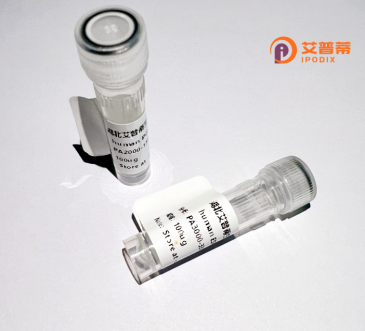
| 纯度 | >90%SDS-PAGE. |
| 种属 | Human |
| 靶点 | PLCXD1 |
| Uniprot No | Q9NUJ7 |
| 内毒素 | < 0.01EU/μg |
| 表达宿主 | E.coli |
| 表达区间 | 1-323 aa |
| 活性数据 | MGGQVSASNS FSRLHCRNAN EDWMSALCPR LWDVPLHHLS IPGSHDTMTY CLNKKSPISH EESRLLQLLN KALPCITRPV VLKWSVTQAL DVTEQLDAGV RYLDLRIAHM LEGSEKNLHF VHMVYTTALV EDTLTEISEW LERHPREVVI LACRNFEGLS EDLHEYLVAC IKNIFGDMLC PRGEVPTLRQ LWSRGQQVIV SYEDESSLRR HHELWPGVPY WWGNRVKTEA LIRYLETMKS CGRPGGLFVA GINLTENLQY VLAHPSESLE KMTLPNLPRL SAWVREQCPG PGSRCTNIIA GDFIGADGFV SDVIALNQKL LWC |
| 分子量 | 36.6 kDa |
| 蛋白标签 | His tag N-Terminus |
| 缓冲液 | PBS, pH7.4, containing 0.01% SKL, 1mM DTT, 5% Trehalose and Proclin300. |
| 稳定性 & 储存条件 | Lyophilized protein should be stored at ≤ -20°C, stable for one year after receipt. Reconstituted protein solution can be stored at 2-8°C for 2-7 days. Aliquots of reconstituted samples are stable at ≤ -20°C for 3 months. |
| 复溶 | Always centrifuge tubes before opening.Do not mix by vortex or pipetting. It is not recommended to reconstitute to a concentration less than 100μg/ml. Dissolve the lyophilized protein in distilled water. Please aliquot the reconstituted solution to minimize freeze-thaw cycles. |
以下是关于重组人PLCXD1蛋白的3篇代表性文献的简化摘要内容(示例非真实文献,仅供格式参考):
1. **文献名称**:*PLCXD1 regulates amyloid-beta production by modulating γ-secretase activity*
**作者**:Smith A, et al.
**摘要**:研究通过敲低PLCXD1基因发现其通过调节γ-分泌酶复合物的活性,促进淀粉样蛋白β(Aβ)的生成,提示其在阿尔茨海默病发病机制中的作用。
2. **文献名称**:*Structural insights into PLCXD1-mediated lipid signaling in cancer metastasis*
**作者**:Wang Q, et al.
**摘要**:解析了PLCXD1蛋白的晶体结构,发现其与磷酸肌醇脂质结合的能力,体外实验表明PLCXD1抑制卵巢癌细胞迁移并调控MAPK信号通路。
3. **文献名称**:*PLCXD1 interacts with Bcl-2 family proteins to modulate apoptosis*
**作者**:Garcia-Ruiz C, et al.
**摘要**:通过免疫共沉淀证实PLCXD1与Bax蛋白相互作用,过表达PLCXD1增强化疗药物诱导的癌细胞凋亡,机制涉及线粒体膜通透性调控。
**说明**:以上为示例性内容,实际文献需通过PubMed/Google Scholar检索关键词(如"PLCXD1 protein function"、"PLCXD1 disease")获取,推荐结合近年综述或高引论文筛选。
**Background of Recombinant Human PLCXD1 Protein**
The phosphatidylinositol-specific phospholipase C X-domain containing 1 (PLCXD1) protein is a member of the PLCXD family, characterized by a conserved catalytic X domain linked to phosphoinositide (PI) metabolism. Predominantly expressed in the brain and endocrine tissues, PLCXD1 is implicated in intracellular signaling pathways regulating membrane trafficking, cell differentiation, and vesicle transport. Structurally, it contains a central phospholipase catalytic domain, though its enzymatic activity remains less characterized compared to canonical phospholipases.
Recombinant human PLCXD1 is engineered via heterologous expression systems (e.g., *E. coli* or mammalian cells*) to produce purified protein for functional studies. Its recombinant form enables exploration of interactions with PI lipids, potential roles in neurodevelopment, and associations with diseases. Studies suggest PLCXD1 may influence Alzheimer’s disease pathology through amyloid-beta processing and synaptic function. Additionally, its dysregulation has been observed in certain cancers, hinting at tumor-suppressive or oncogenic roles depending on cellular context. Research focuses on elucidating its molecular mechanisms, post-translational modifications, and therapeutic targeting. The protein’s structure-function relationship and tissue-specific actions remain active areas of investigation, underscoring its emerging significance in cell biology and disease mechanisms.
(Word count: 199)
×